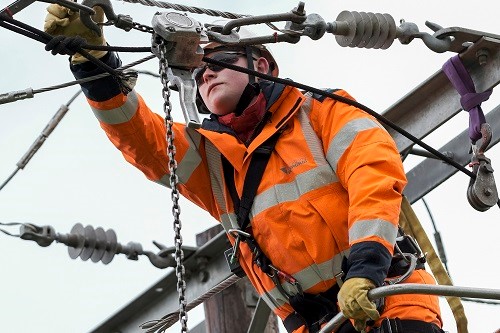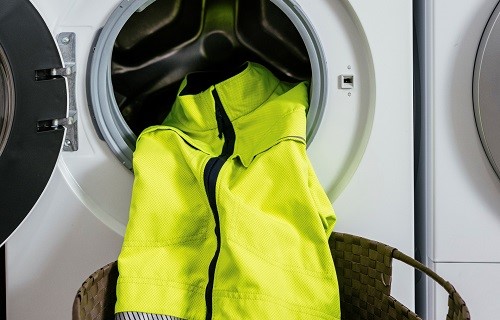Arc rated PPE provides vital protection against electrical arcing for people such as engineers working on electrical installations, but it’s crucial to consider factors like comfort, durability and weather protection when selecting it.
Features
Getting arc rated PPE procurement right
A full risk assessment is a necessary practice for all employers to effectively manage risks in the workplace and to use as a blueprint for any required personal protective equipment (PPE) provision.
Accidents and exposure to risks, such as heat, flame and electric arc, are more likely to happen when PPE is discarded or only used sporadically because the garments aren’t comfortable to wear. In addition, studies show that workers are more productive if they feel safe, well protected from work-related risks and are wearing comfortable ergonomic and lightweight garments that move freely.
 Arc rated PPE is designed to protect the wearer from electrical arcing, sometimes called a flashover or arc flash. Photograph: GORE-TEX
Arc rated PPE is designed to protect the wearer from electrical arcing, sometimes called a flashover or arc flash. Photograph: GORE-TEX
The following key aspects should be carefully considered when procuring weatherproof and arc rated PPE. Arc rated PPE is designed to protect the wearer from electrical arcing, sometimes called a flashover or arc flash. An arc flash can occur for a variety of reasons – including due to a short electrical circuit caused by unsafe working practices – and can generate intense heat leading to serious and even fatal burns to those nearby.
Arc rated GORE-TEX Pyrad garments have countless little dots made of a graphite material on the outer fabric. In everyday use the fabric remains lightweight, supple and flexible. If a flash fire or electric arc incident causes the dots to heat up suddenly, they react immediately to form a stable carbonaceous char that effectively blocks the massive convective heat flow during arc exposure.
Always ask the wearer
Sensible and legally compliant employers know the regulations and safety risks they need to protect their employees against but a good place to start is to also make sure workers are consulted on what is important to them with their PPE. The full involvement of workers in wearer trials and their feedback on prototypes is a really good initiative and will help ensure effective and modern designs are keeping workers safe in high-risk situations.
 PPE must be washed in order to restore its performance. Photograph: GORE-TEX
PPE must be washed in order to restore its performance. Photograph: GORE-TEX
Increasingly, workers demand that their PPE is comfortable as well as safe, so this should also be at the forefront of the employer’s mind. Too hot, cold, leaky or heavy and no matter how good the product is in protecting against danger, the wearer is less likely to use it.
Review the latest fabric technologies
In the competitive workwear market, designers and manufacturers now need to be spot-on in terms of developing the latest fabrics for protection in combination with wearer comfort. High-tech safety materials ensure that electrical engineers and industrial workers can rely on their PPE.
Increasingly there is wider availability of lightweight multi-norm garments which protect against more than just the elements but also against additional risks, such as electric arc flashes. For example, new Arc Rated GORE-TEX PYRAD® Stretch jackets and trousers have 50 per cent more stretch than other existing products currently available and are 45 per cent lighter than other Class 2 arc protection rainwear.
Consider functional design solutions
A growing trend is emerging where workers want to wear modern and comfortable safety clothing in a professional environment, in the same way they wear functional and contemporary garments for sports and leisure.
 Jonas Andersson, professional sales associate at GORE-TEX
Jonas Andersson, professional sales associate at GORE-TEX
Also, ‘comfort mapping’ is increasingly used by designers; this involves considering the distribution of heat and moisture production in various parts of the body and using contrasting textile materials for different parts of the garment, to prevent overheating on warm days or during heavy work.
Workwear designers now balance safety with functional style by combining materials science, technological knowledge and innovative design. Electrical utility workers, for example, benefit from ‘Nelson’ pockets on their jackets large enough for holding switching books and narrow jacket cuff designs so that gauntlet gloves can easily be put on over these.
Engage with end users about new PPE
Even where currently used PPE is less than effective, some workers may be reluctant to try a new product. Wider acceptance can be aided via internal communication with workers about ongoing wearer trials.
Within many industries employers host educational roadshows either online or face-to-face. These enable fabric technology to be explained in detail, benefits of the new styles can be illustrated in a direct and practical way and wash and care instructions can be communicated.
Wash and care for PPE
An important aspect is to care for the PPE. As garments get dirty and end-users sweat during work, the PPE must be washed in order to restore its performance. Employers should check if products are lab tested and proven to withstand wash and care cycles and still durably perform.
PPE availability
Once employers and end-users have selected their PPE, it is a smart move to work in partnership with suppliers to develop a speedy ordering and delivery system. A dedicated Cloud PPE Online Ordering System is used by some large-scale employers to ensure that products are delivered the next working day to the individual.
Sustainability through durability
Everyone has a role to play in environmental stewardship and adopting a sustainable approach to workwear provision. A core feature of sustainability is finding ways to avoid throw-away cheap clothing. Using products and materials that are designed to be long lasting, that can be repaired and reused and then recycled is a firm step in the right direction.
The best way of achieving a sustainable approach and reducing environmental impact in the workwear sector is the production, procurement and use of durable products designed for longevity. According to the lifecycle assessment, the longer clothing and footwear products are in use, the lower the environmental footprint will be.
Credible manufacturers and suppliers within the workwear industry adhere
to environmental programmes and standards, such as the ISO standardised method for environmental assessment of products and services, including ISO 14001 or Life Cycle Assessment (LCA – ISO 14040) but also compliance to standards such as Standard 100 by OEKO-TEX.
Wearer satisfaction levels
In the end, PPE is worn by real people in real working conditions. The provision of new safety workwear should always provide high satisfaction levels for the end user. Comfort, style and thermal regulation in high performance fabrics must work together so that the end-user feels valued, safe and fully protected to work long hours in the supplied PPE.
For more information see: goretexprofessional.com/uk/arc-rated-garments
Jonas Andersson is professional sales associate at GORE-TEX
FEATURES

Sedentary working and how to combat the ‘sitting disease’
By Gavin Bradley, Active Working on 05 April 2024
Prolonged and excessive sitting poses a major risk to our health, but the Get Britain Standing campaign and On Your Feet Britain Day on 25 April are a great way of encouraging workers to sit less and move more.

Company culture and wellbeing: a crucial link
By Bex Moorhouse, Invigorate Spaces on 05 April 2024
Investing in measures to support worker wellbeing will be ineffective unless the company culture genuinely incorporates values like teamwork, involvement, flexibility and innovation.

Office design and culture: happier and healthier staff – or the opposite?
By Guy Osmond, Osmond Ergonomics on 03 April 2024
Applying ergonomic principles to workstation set-ups and ensuring the physical environment supports neurodivergent people are just some of the ways of creating an office where everyone can thrive, but a supportive and positive organisational culture is vital too.


